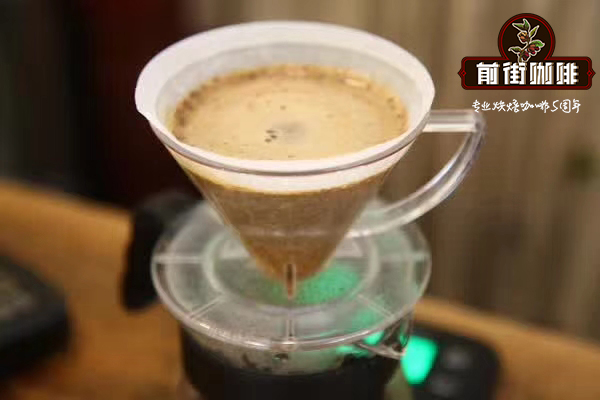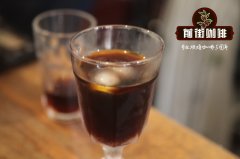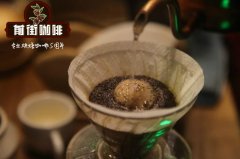Factors affecting the quality of Espresso and three factors affecting the extraction time of concentration
Factors affecting the quality of Espresso
Coffee beans
It is impossible to make a good Espresso without a good mix of coffee beans. Mixed beans must be matched with the sweetness, aroma and lubrication required by Espresso.
Baking
Deeply roasted beans will taste bitter and scorched, and excessive deep roasting will even make the coffee lose most of its flavor, while experienced bakers will use medium and deep roasting to keep the Espresso sweet. Different baking degrees will bring different flavors and need to be matched with different extraction parameters.
Grinding
The degree of grinding is too rough, the flow rate is too fast, and the extraction is insufficient.
Proper grinding degree, normal flow rate, complete extraction.
The degree of grinding is too fine, the flow rate is too slow, and the extraction is overdone.
Under normal extraction conditions, too coarse powder will cause water to flow through the powder bowl too fast, rough water, light extraction, white color, sharp acid flavor, because the extraction is incomplete, only the acidic substances on the surface and easy to extract are extracted, if the extraction time is long, it will also be over-extracted on the surface, but not enough extraction inside, showing as acidity, because of the lack of sweetness, and then bitter and astringent mouth. If the powder is too fine, it will first block the filter hole, the water can not flow out or the water column is too thin, the oil color is dark, the extraction is excessive, the high temperature and high pressure are all contained in the powder bowl, bitter, mixed, and there are all kinds of good and bad flavors.
Receive powder and cloth powder
After grinding and before pressing the powder, the coffee powder must be evenly distributed in the powder bowl of the handle.
Filling strength
There are various styles of packing. In this world, almost no two people's packing will be exactly the same. Generally speaking, if it is heavy pressure, the required pressure will be the pressure like 25kg/m2, but packing is actually the freest parameter. The key is to press it smoothly and evenly.
Hydraulic pressure
The ideal water pressure of Espresso is generally 9 BAR, which is generally recognized as the most ideal extraction pressure.
Water temperature
The water temperature depends on the needs of different varieties of coffee beans, some are subject to boiler pressure, while others are more flexible and precise. According to the experience of most baristas, the water temperature is between 90 and 92 degrees Celsius, and each barista can adjust flexibly according to his or her own understanding and needs.
Powder quantity
The amount of Espresso powder for a single serving is 7 to 10 grams of coffee powder, and that for a double serving is 14 to 20 grams, depending on the maximum powder content of the powder bowl and the formula of the coffee shop.
Extraction time
The extraction time of Espresso gold cup extraction is between 20 and 30 seconds, but the extraction time is actually a comprehensive performance of packing pressure, powder amount and grinding degree, which needs to be adjusted by barista's understanding of Espresso.
Extraction quantity
The older term is that Espresso has a single 30ml extract and a double 60ml extract, but its practical electronic scale is more accurate than the volume, because the state of the coffee beans affects the volume of the oil. The specific value depends on the ratio of gouache to powder.
There are three factors that affect the extraction time of concentration:
Particle size of powder
Imagine two pipes, one filled with stone and the other filled with sand. When the water flows through, the pipe filled with stone must be faster than the one filled with sand. In fact, this truth is also applicable in concentrated extraction. The resistance of fine particles to water is greater than that of coarse particles.
The magnitude of the pressure
The coffee machine is set to 9bar pressure, which is a pressure that can be used by most machines, and as you can imagine, the smaller the pressure, the slower the concentration. In general, the traffic is about 250-500ml/30 seconds. You can measure it-take off the handle of the coffee machine and press the extraction button, then catch the water flowing out and measure it. I found that it is optimal if the traffic is in 200-280ml/30 seconds. Even if each head on a machine has a different flow rate.
The difference between powder net
The difference between powder mesh is mainly in the size of the hole. This is called the "total open area" referred to as TOA. More TOA will make it easier for water to flow through the powder net, but don't worry too much, we are already using VST powder net.
So focus our most attention on the particle size of the powder, because you will spend the most time on it. Once we have locked in the liquid weight and powder weight, then we are left to determine the extraction rate by adjusting the time. Adjusting the degree of grinding will involve increasing or decreasing the strength or extraction rate at the same time.

Important Notice :
前街咖啡 FrontStreet Coffee has moved to new addredd:
FrontStreet Coffee Address: 315,Donghua East Road,GuangZhou
Tel:020 38364473
- Prev

World's most expensive Coffee ranking of Coffee in recent years
Professional coffee knowledge exchange more coffee bean information please follow the coffee workshop (Wechat official account cafe_style) Blue Mountain Coffee (Blue Mountain Coffee); Blue Mountain Coffee is native to the mountains of Jamaica in the West Indies, its rich aroma, mellow taste, excellent quality, with a variety of quality coffee characteristics. It's the best in coffee. But the output is very small.
- Next

How do you make coffee with flannel cloth? Steps to brew coffee with flannel cloth
Professional coffee knowledge exchange More coffee bean information Please pay attention to coffee workshop (Weixin Official Accounts cafe_style) flannel filter cloth hand brewed coffee (Nel drip) taste mellow, thick, and has an incredible sweetness, reminiscent of sweet wine. It's not easy to brew good coffee this way. Too fast, too hot, and too poorly done will detract from coffee.
Related
- Beginners will see the "Coffee pull flower" guide!
- What is the difference between ice blog purified milk and ordinary milk coffee?
- Why is the Philippines the largest producer of crops in Liberia?
- For coffee extraction, should the fine powder be retained?
- How does extracted espresso fill pressed powder? How much strength does it take to press the powder?
- How to make jasmine cold extract coffee? Is the jasmine + latte good?
- Will this little toy really make the coffee taste better? How does Lily Drip affect coffee extraction?
- Will the action of slapping the filter cup also affect coffee extraction?
- What's the difference between powder-to-water ratio and powder-to-liquid ratio?
- What is the Ethiopian local species? What does it have to do with Heirloom native species?

